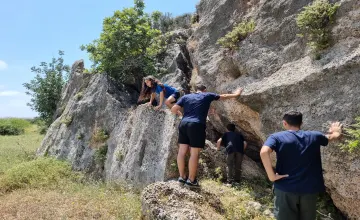Trip Duration: 1-2 hours
Trip Type: Observation, flower trail, and historical sites
Difficulty Level: Easy, suitable for all family members
Accessibility: Not stroller-friendly
Cost: Free of charge
Location: Northern Israel - Atlit
At the entrance to Atlit, you will find a short and easy trail that leads up the Kurkar ridge, offering panoramic views of the surrounding area, carved stables, and, during the blooming season, a variety of beautiful blossoming flowers. After the rains, anemones and hollyhocks bloom, while in the fall, hollyhocks create a stunning sea view.
There are two starting points for the trail:
Limor parking lot: This starting point features numerous picnic tables and a small ninja track-style playground for children. The trail is marked with blue and white, leading from the parking lot to the Karta ruins. You can choose to complete the full circular route, approximately 1 kilometer long, or park another vehicle at the second entry point. The trail markings will then change from blue to black for a 600-meter stretch.
End of road 7110 in Afar Square: Continue straight at the square (with the climbing museum to your right) and follow the road as it curves left. After crossing the Nahal Oren estuary bridge, the trailhead will be on your left. This starting point offers a large dirt square and prominent signage from the Nature and Parks Authority. The trail is marked with black and later turns blue. You can park here and finish at the Limor parking lot, or vice versa if you have two vehicles.
Kharbat Karta was declared a nature reserve in 1996 and spans 137 dunams. The reserve contains typical habitats and an archaeological site, the Detroa Fort, which is a Crusader fortress built by the Templars. The fort's strategic location connected northern coastal cities, like Acre, with southern cities, such as Caesarea. The fortress, which measured 21 x 18 meters, was surrounded by walls and featured a lower section carved out of the kurkar rock, with mines reaching up to four meters.
Inside the reserve, you will find:
Panoramic views from the water pool: A large concrete structure houses a former water pool, and an impressive view of the entire area can be seen from atop the structure's stairs. The view includes the Carmel Ridge and the city of Haifa to the north, the Yaakov memorial and surrounding settlements to the south, and the coastline, Atlit fortress, salt ponds, and Jessar al-Zarqa area to the south.
La Detroit Fortress: This archaeological site is located within the Karta Ruins Nature Reserve and can be accessed via a short climb using pegs.
Rock-engraved letters: On the ridge's eastern side, you will find the letters A and U in Phoenician script. Some believe these letters represent the first letters of the city's name, "Atlit," although this cannot be confirmed.
Carved stables: On the southern side of the Kurkar ridge, you can view the stable rooms resembling large tunnels or sheds.
Blooming season: From January to March, visitors can enjoy a wide array of colorful blossoms along the short trail, including cyclamen, anemones, and poppies. In autumn, the sedge blooms are especially impressive.
Salt pools and flamingo observation: While in the area, don't miss the Atlit salt pools, where flamingos come to rest.
To reach the reserve, use Waze app or other navigation apps:
For the Limor Parking Lot, enter "Horvat Karta - Horesh Limor, Atlit."
For the second entry point at the end of Road 7110, enter "Horvat Karta Nature Reserve - Atlit, North District."
From Road 2, exit at the Atlit interchange and turn left or continue straight at the first square, depending on your chosen starting point.








